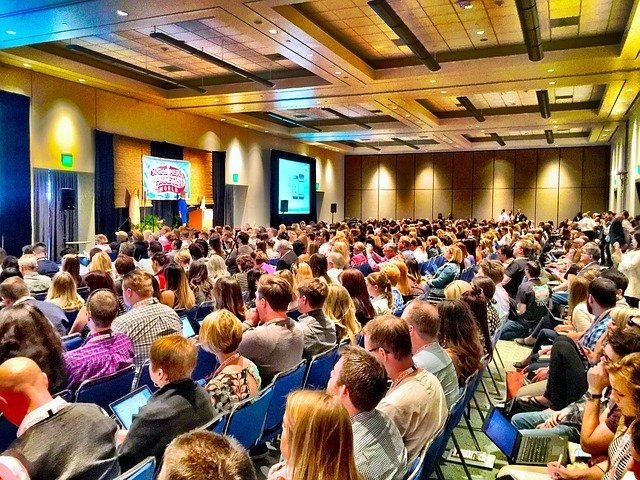
Why Event Marketing Works and Then Some
71 percent of internet users feel that ads are more intrusive than they were just a few years ago. Understandably, people prefer messaging and content that directly speaks to their needs and goals over being bombarded with brand advertising.
So what’s one of the most powerful content marketing tools used today? Event marketing.
Major marketing events, with their product demonstrations, live speakers, hand on experiences, face-to-face interactions, have the ability to offer a deeper level of worth to consumers than other content because they combine value with experience. Instead of just reading an educational blog post, at an event, customers get to listen to the expert live, ask questions, and engage with other like-minded individuals. Instead of watching a how-to video to see how a product works, they can try it themselves and receive the guidance they need to help them get more out of the products they are using.
This shift in consumer behavior and preferences is echoed by experienced marketers. 58 percent of marketers consider conferences, trade shows, and other events to be important for improving the customer experience. For B2B marketers, the appeal of in-person marketing is even higher. 67 percent believe events are their most effective content tool.
According to Forrester, event marketing makes up the largest portion of B2B marketing budgets, about 20 percent. Approximately $108 billion is spent on event hosting each year – in the US alone. With event marketing comprising 20-25% of overall marketing budgets, it is obvious that event marketing is here to stay. Clearly, not everyone needs a giant ferris wheels at Cannes Lions (thanks Snap) or the Bumble Bus at SXSW, but companies are realizing the power of experiential event marketing. With this explosion comes the question: What’s next?
The Benefits of Event Marketing
In-person events, i.e. human interaction, simply have more impact than all the social media posts and email newsletters in the world. This is true both when they happen and afterward with the event echo effect. When you take part in the best marketing conferences, you have a real opportunity to build interest, generate burning hot leads, and make a few sales on the big day.
But the biggest boon comes after the fact when you repurpose your event content and grow your brand community post-event. Here are some specific advantages a brand or business can get from event marketing.
An Authentic Buyer Perspective
The knowledge gained from face-to-face interactions with customers is critical for creating – and leveraging – accurate buyer personas. For B2B brands, in particular, customer interaction may be limited to emails, brief online chats, and an occasional phone call.
With real-time, human engagement, the quality of the feedback and insight you’ll receive will be tremendously valuable for enriching your buyer personas and improving the experience and products you offer your customers. You may discover a problem with your product or services that is the root of unexplained customer churn. On the other hand, you could uncover strengths you didn’t realize you had, which your brand can now better capitalize on.
- Talk with clients or interested prospects at a conference over coffee.
- Take notes during the interactive Q&A session.
- Encourage attendees to reach out to you or your team directly with questions or concerns.
- Use a branded mobile event app to encourage interaction with your attendees, to launch discussions, and to send out survey requests.
Stronger Customer Connections
Content marketing and marketing experiences – live events and experiential content – are driving brand awareness, customer loyalty, and sales in big ways. Eventmarketer’s latest research, EventTrack 2018, which surveyed consumers across industries, revealed that 85 percent of consumers are likely to make a purchase after an event and 91 percent feel more positive about a brand.
Sue Duris, Director of Marketing and Customer Experience for M4 Communications, explains the rich benefits of experiential marketing, which includes events as well as other live, personalized experiences such as real-time webinars.
“These live experiences connect consumers to brands in a personal and purposeful way. Customer experience and experiential marketing converge in the creation of dynamic, rich, and emotional connections with consumers that can generate brand loyalty.”
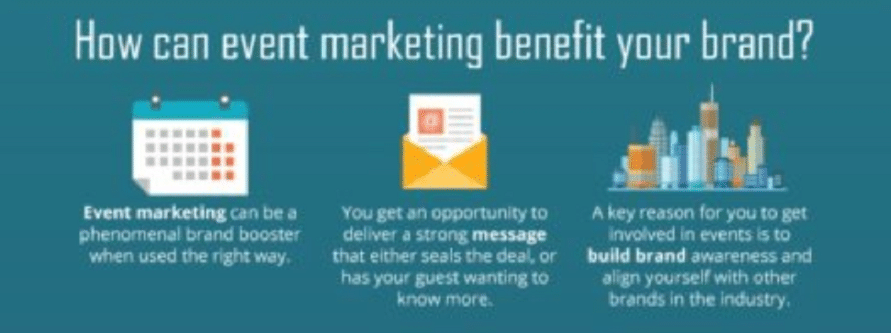
More Social Media Engagement
Another advantage of event marketing is how it can drive social media engagement. Become the brand that everyone is talking about by building up excitement on your social channels pre-event, posting stats, quotes, and even live streaming during the event, and sharing highlights after it occurs.
- Offer discounts, prizes, or other perks to social followers to claim in the lead-up to your event.
- Encourage attendees to sign up for your business’s social sites by running a contest on one of your social platforms, such as the attendee that shares the best picture, or finds the answer to a riddle (something that can be only solved at the event) first.
- Let people know with fliers or announcements that post-event news, photos, and insights will be shared directly on social media.
- Project your brand’s live Twitter feed at the event to motivate more social posts.
Encouraging more social engagement will help to build your brand’s community. The people who attend your events are likely to be your long-term customers, as well as your brand advocates. Get them connected with your business on social media so they can conveniently share your riveting blog posts and inspirational podcasts and vlogs in the future.
An Effective Content Strategy
Including in-person events in your content marketing strategy gives your more motivated buyers and loyal brand advocates a chance to take a step further into your brand, immersing into a real-world environment rather than just a digital one.
Your event can even help to increase traffic to your site and boost your brand’s search engine rankings. One way to do this is to use an interactive event calendar. By using SEO optimized images, RSVP information, social media connections, and metadata, you are effectively offering search engines a rich list of quality information to index.
As a bonus, if your event calendar integrates with your marketing software, it can also be used to gather customer information, improve your segmentation, and learn more about how your customers interact with your event listing.
Speaking of inbound marketing, you can repurpose your event content into months worth of high-quality content. Fill up your blog schedule with value-driven posts related to the event. Conduct interviews with speakers and share on your social media channels. Post pictures, videos, and standout quotes.
You can also create an event survey to gather data for an original report covering current insights in your industry. Especially if you have a large attendee list, this can be an excellent way to collect valuable market information, which you can then repurpose into a white paper to share with your existing customers or to offer on your website to attract leads.
A More Meaningful Brand
Event marketing works. As those winning event metrics keep coming in, brands are going to continue offering more in-person experiences for their customers. The US Bureau of Labor Statistics forecasts the event industry to grow by 44 percent from 2010 to 2020!
While the ROI for events varies – big budget brands claim they see a return that exceeds 5 times their investment for live events, while about half of brands across the board put their return between 3 and 5 times what they invested – the majority of companies who use events believe the impact in terms of lead generation, sales, and customer loyalty is worth it.
Consumers are gravitating towards more meaningful brands. The ones that offer real value. That can improve their lives. And that can step through the wall that traditionally stands between consumers and business to offer something human.
Experiences Continue to Dominate
Event swag is dead.
“People aren’t as interested in receiving their t-shirt or pen at the booth for a sales pitch, they want to learn through experiencing the product. Sponsors are going to be pressed to come up with unique ways to do that, whether it be VR, games, or problem solving at the booth,” says Kevin Benson of G2Crowd.
Kevin has been on their marketing team for three years now and has scaled G2 Crowd from sponsoring and attending 10 events a year to over 55. Pretty impressive.
In 2017, Kevin’s team sponsored Dreamforce and featured several online and offline ways to experience the G2 Crowd brand in real-time during the event. They were a part of seven different sessions at Dreamforce, hosted an intimate VIP dinner, an executive breakfast, a party at Hakkasan, a happy hour, and sponsored Ops Stars.
They also created their digital “G2 Crowd Dreamforce 2017 Grid®!” to help sponsors prioritize who they should visit in the Cloud Expo at Dreamforce, which was updated in real-time.
That’s a lot of experiences and everything is focused on defining their brand, which, if you didn’t know, is one of the largest B2B software review sites.
We beg you to stop with socks, coasters, mints, hand sanitizer, candy, usb drives, flashlights, backpacks, notebooks, pens, water bottles, tote, phone chargers, t-shirts, keychains, Moleskins, phone cases, paperweights, sunglasses, bluetooth speakers, baseball hats….
Video Goes Mainstream at Events
“Video marketing will continue to grow, with short, snack-like formats.”
Michael Heipel is an event professional with over 25 years of experience.
“Video keeps playing a more and more important role in online communications. Every event needs a video communications strategy, which implies not only one single content product (e.g. a wrap-up movie), but lots of small bits of “content snacks” in video formats,” says Michael.
But, as Michael points out, it’s not just about the big flashy wrap-up video – it’s about the bitesize chunks before, during, and after the event. We predict creating a cohesive video strategy that B2B companies can reuse in their other marketing efforts will be at the forefront of many marketer’s minds this year.
Michael gives some helpful hints about producing these “content snacks”.
Focus on… “creating animated infographics, short interview snippets, impressions videos, Facebook live interviews, broadcasts etc. in high frequencies.”
CMOs Still Want to Know: What’s the ROI?
“It is becoming increasingly more important for event marketers to defend their budgets, and the best way to do that is to prove the ROI from a given event.”
Preach, Tom Spano. Tom is a Global Director of Event Marketing, a keynote speaker, and one of the founders of Haute Dokimazo – dubbed “a new kind of conference”.
“Gone are the days of post event surveys and registration successes. We all know that a packed house doesn’t mean higher sales. We need to prove that the right people packed the house and we need to show the sales were attributable to that event so we can do it again next year. Or, more importantly, we can decide not to do it again next year if the ROI was not at an acceptable level.”
7 Surefire Ways to Improve Brand Events
Unlike a piece of content that lives online, a live event can eat up a much bigger pie of your marketing budget. According to Forrester, the average CMO allocates 24 percent of the annual marketing budget for live events. So, you want to make sure events are really, really good.
In order to get the most impact out of your event marketing then, why not give your participants more of what they actually want? Try addressing these things:
Understand Your Event Audience
With the use of event apps, the customer data in your marketing automation software and event management software, and fresh insights from attendees, you can learn a lot about who your attendees are with each event. Try creating special event attendee personas, in addition to the buyer personas you already have. You may have only one or two segments of your buyers who attend. Then, you can focus the tone and content of your event for attendees rather than all your buyers.
Create a More Welcoming Experience
This is one detail that you don’t want to overlook. People should feel welcome and appreciated at your event. This is both the first and last impression you want to cast.
- Before the event, use personalized communication through email, mailings, phone calls, or social media channels dedicated to event registrants
- During the event, have dedicated staff for welcoming people when they arrive and to talk to attendees during the event
- Post-event, use follow-up communications for thank you’s, personalized content offers, feedback requests, and opt-in offers for early registration for your next event
Use Gamification
Live events are a great channel for using gamification to engage customers. The type of interactive games or competitions you use will have to be specific to your industry, brand, and audience but some form of interaction can help attendees get into the experience. This is where having an event app can be really useful, especially for conferences and other larger events. You can tie your gamification into the app. For smaller events, such as trade booths and product demos, you can create fun contests for participants where they can win a prize for answering questions or completing a task.
Educate Your Audience
Events and experiential marketing can entertain, inspire, engage, and inform. But, if someone is going to spend the time to come to a live event, to register and commit themselves, and for almost 40 percent of events, to pay an admission fee, they need to gain something from coming.
According to EventTrack, people do want to learn at events. If you already have an educational element or focus, take a look at what level of information you are presenting – are you adding knowledge to your attendees or telling them what they already know? If your event is more about demonstrating your product or creating a fun experience, figure out a way to add an educational element as well for those attendees who do want to learn more.
Show and Tell
Consumers who have attended events say they want to see more of how a product works. For both products and services, you can demonstrate how something works and what impact it can have on those who use it. Demoing software, cooking demonstrations, case studies and results data – when people show up to your event, find a way to show them why your brand is worth showing up for. This is how you really let your audience step into your brand’s world.
Give Away Generously
Okay, swag isn’t totally dead. People don’t like to just take away knowledge. They also like something physical. If you have a physical product, samples are a good idea. For B2B brands and service-based companies, you’ll have to get creative with your event swag.
Make It Entertaining
Make it fun. No matter how informative your event may be, or how professional your audience, this is event marketing, not another meeting at the office. You should integrate some level of fun and enjoyment – engaging, witty speakers, the opportunity to interact in even competitions and games as mentioned earlier, and adding a little awe with VR, projection mapping, and other next-gen technology.
New Trends are New Opportunities
Event technology that can solve the biggest hurdles event marketers face including attribution and ROI are poised to dominate the market this year. We’ll continue seeing new ways brands can connect the offline event experience to their online audiences, especially through video and virtual experiences.

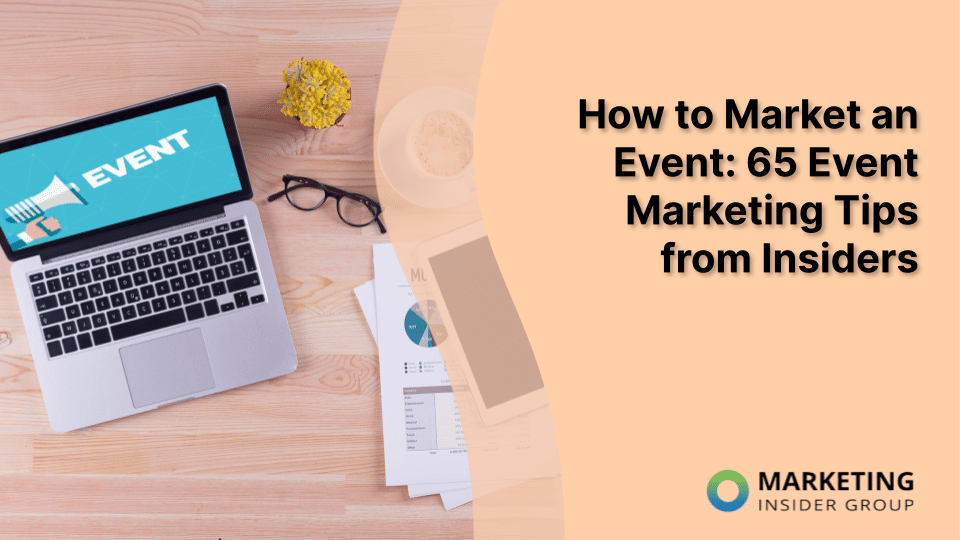
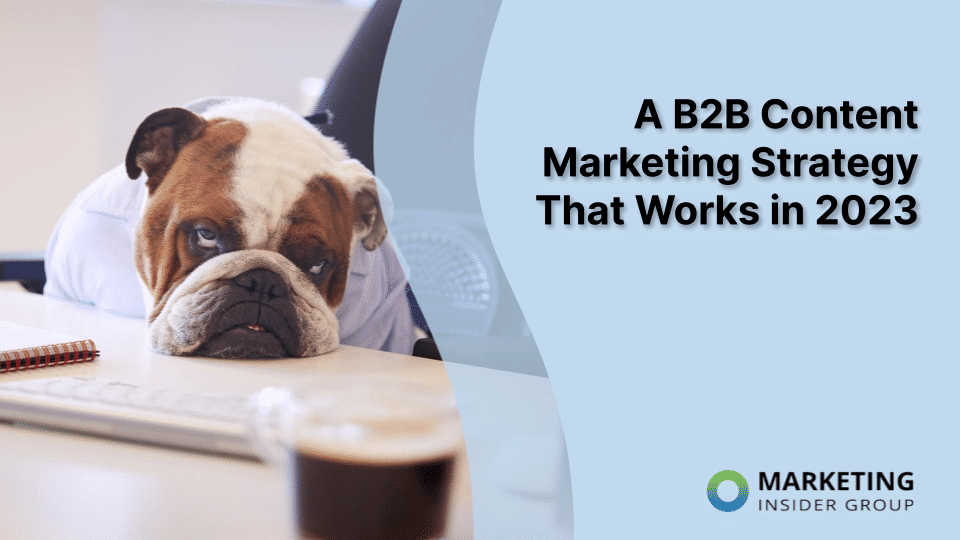
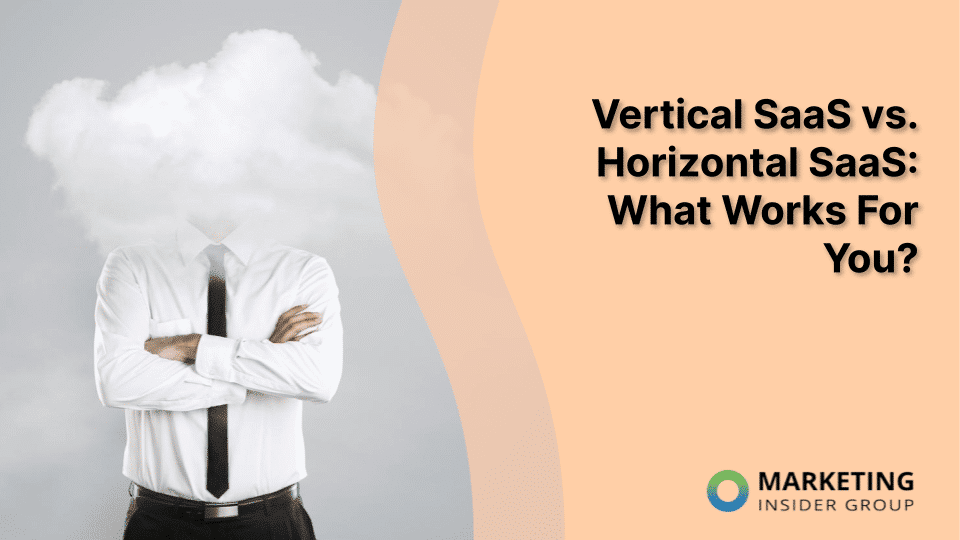



Absolutely – as per my personal experience, Twitter is probably the best platform to build up interest and engagement before, during and after an event.